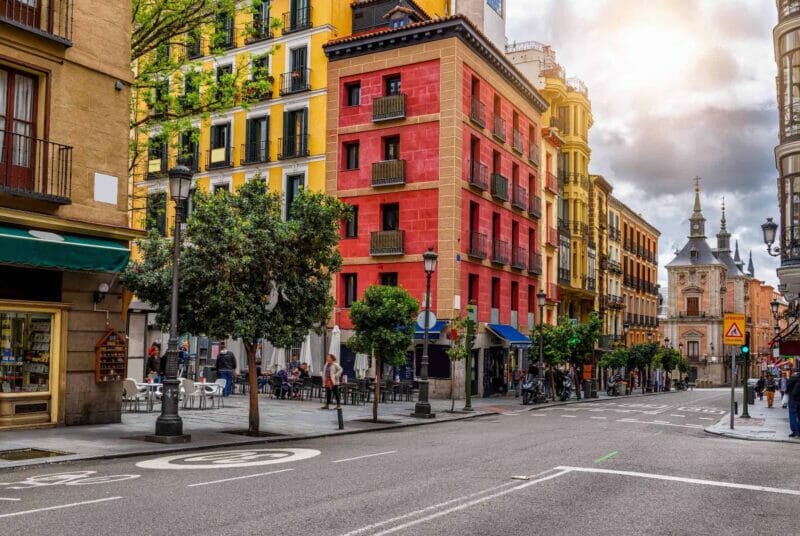Madrid is located in the heart of Spain and is not just the country’s capital but a bustling social, cultural, and economic hub as well. Madrid has so much to offer expats, whether you’re looking for new job opportunities, a new setting, or somewhere to retire that isn’t too quiet.
Here are the positives and negatives of living in Madrid that can help you make up your mind about whether this wonderful city can be on your list of possible places to move to.
Is Madrid a good place to live?
The vibrant metropolis houses a Royal Palace, world-renowned art galleries, amazing nightlife and cultural scene, plus countless job and economic opportunities and excellent transport connections both domestically and abroad.
There are a lot of advantages to moving to Madrid, but like anywhere in the world, it does have a few drawbacks. This begs the question: Is Madrid the right place for you? Let’s find out!
What’s it like to live in Madrid?
Living in Madrid is living in a modern, sprawling city with the history and Latin charm that you would expect from the Spanish capital.

The people, known locally as Madrilenos, are welcoming and open. Madrid is home to beautiful boulevards and classic architecture, as well as many cultural and social attractions.
The climate is appealing, especially in summer, with an average temperature of 25C. You will still need to pack a coat, however, as the average temperature can get as low as 6C at the peak of winter.
The cost of living is generally cheaper than in northern countries, especially when it comes to everyday items and going out.
Madrid is an excellent place if you’re looking for all the fun and bustle of a major city without the frantic pace of places like London or New York. Spain is the home of the Siesta, after all!
Although the traditional siesta is very different, particularly in major cities such as Madrid, the value placed on time spent with loved ones is still deeply rooted. In Madrid, people work hard and play hard, so expect later nights spent laughing, eating, and drinking with friends on a regular basis.
Is Madrid a good place to live?
Madrid is a great place to live, especially for professionals, remote workers, and semi-retired business owners with a steady stream of income.
Seeking the sea? Then Madrid is not the place for you. It isn’t coastal. However, you do have the option of taking yourself to any of Spain’s beautiful seaside cities if you wish. You will find plenty of options in our guide to Spain’s Costas and coastal areas.
Madrid has everything you need to live comfortably. Infrastructure is good and well maintained, the public transport system is affordable and efficient, and the healthcare services are considered some of the best in the country.
Salaries can be lower than those in places like London. However, the cost of living is generally cheaper, and the weather is better.
Plus, despite the relaxed way of life, Madrid is a city full of excitement. It is home to everything from some of the world’s best museums and art galleries to a host of theatres, cinemas, leisure centers, exhibition halls, sports centers, parks, and malls.
You will never run out of things to do in Madrid, no matter what age you are and what takes your fancy on the leisure side of life! However, this vibrancy can come at a bit of a cost (more on this later).
Is living in Madrid expensive?
Generally speaking, Madrid is considered cheaper to live in than other major cities like London.

Everyday items are affordable, with fresh bread costing 50 cents and a bottle of wine between €3-4.
On average, you can expect to get a week’s worth of meals for roughly €30-40 from a market or grocery store.
One thing to note is that there is a massive “going out” culture in Madrid, so expect to eat out regularly.
Big lunches are the trend, and many restaurants outside of tourist hotspots do specials for as little as €10-12, which will often include a glass of alcohol, a large starter, main, dessert, and coffee.
Small tapas, or tapa plates, can cost as little as €3-4, and a bottle of local beer will cost the same. It’s also worth noting that many tapas bars will give you small plates as you order drinks, so you won’t be paying directly for the food (awesome, right?).
Madrid is considered one of the most expensive places in Spain for property. Depending on how long you choose to stay will determine if you rent or buy.
If you are planning to rent, read our Renting In Spain guide first to make sure you know what to expect and how to protect yourself as a tenant.
To understand how the property purchasing process works in Spain and how to avoid possible pitfalls, read our Buying A Property In Spain guide.
Given the population density of the city, apartment living is the norm.
A one-bedroom apartment outside the city center can cost as little as €650 per month in certain areas. However, as with any major city, the trendier the area or, the closer to the center it is, the more expensive it will be – typically in the range of €1000-€1400 per month.
A three-bedroom apartment, depending on location, can cost anywhere between €100 and €2,200 per month, which is a consideration for families. Utilities will be roughly €150-200 depending on usage.
There is a universal healthcare system in Spain. However, it can sometimes be overburdened. It’s recommended you get private insurance, which will add to your expenses.
Some expats opt for international health insurance. To make sure you get the best value for money, compare international health insurance options from various providers to find the best deal.
Transport is very affordable and efficient, getting you almost anywhere in the city with ease.
A single journey on the metro or bus will cost €1.50. However, there are alternatives such as a 10-journey ticket (€12) or a monthly transport card (available for residents of Madrid), which will cost €20 a month for students and up to €54 a month for non-concessions. These cards provide unlimited travel on the metro/buses.
This all seems rather affordable until you consider that Spanish salaries are notoriously small. So we recommend securing a job before you arrive to understand your budget better. Moving to Madrid when your income is secured (when you are retired, semi-retired, or work remotely) is much easier.
Is it safe to live in Madrid?
Madrid is generally considered a very safe place to live.

Like in any major city, crime is present. However, in no way at a level that should cause concern.
One thing to be mindful of is pickpockets. It pays to be careful on public transport or at major tourist attractions.
It’s worth noting that Madrid has been listed as the 13th safest city in a list of 60 of the world’s largest cities.
The pros and cons of living in Madrid
Just like anywhere in the world, there are both good things and bad things about Madrid. Before your move, here are the main things to consider:
The pros of living in Madrid
1. Plenty of things to do
Simply put, there is so much to do in Madrid. Even after years of living here, it’s unlikely you’ll get to everything.
There is something for everyone, and some of the major highlights include the main square, Royal Palace, Retiro Park, the Temple of Debod, the KIO Towers, and the Grand Via. Once you’ve soaked up the sights, you can then explore the maze of tapas bars, world-class restaurants, cafes, and markets.
A particular highlight is Madrid’s art scene. Madrid is home to some of the best art galleries in the world. If you’re unsure where to start, the Golden Triangle is the place for you. Here, you’ll find The Padro, The Reina Sofia, and The Thyssen-Bornemisza.
2. Slower but urban lifestyle
One serious advantage of living in Madrid is the lifestyle.
The people are warm, welcoming, and friendly. Life also moves a little slower here, so for those who want life in a big city without the bustle, this will give you the lifestyle you want.
Here, you can spend your evenings with friends in various tapas bars or beautiful parks, enjoying the warm weather, local cuisine, and the stunning city. There is a lot to love.
3. A more affordable cost of living
The cost of living is generally more affordable compared to the USA, UK, or northern European capitals. , especially when it comes to going/eating out.
This means you can explore and live a more social life with ease – which is all part of the expat experience, after all. This is especially appealing for expats who are financially secure as they can make the most of their time here.
4. Good weather
The winters can be cold, but that is more than made up for when it comes to summer. Spanish summer is hot and long. So, for those seeking an escape from harsher winters and a taste of European summer, Madrid is definitely worth considering.

The cons of living in Madrid
1. Lack of coast
Despite everything that Madrid has to offer, it doesn’t have a coast or beach. So, for those seeking a more coastal lifestyle in Spain, you will need to look elsewhere.
That being said, it is an excellent place to set up a base from which you can visit any of Spain’s many coastal locations.
2. Lower salaries
There are many job opportunities on offer in Madrid. However, salaries are notoriously low, which can detract from the affordable cost of living.
For expats seeking to find work here, this is something worth considering. With this in mind, we would recommend looking into Madrid if you are working remotely or not dependent on sourcing income here.
3. Smog
The air quality in Madrid is not the best. As one of the most densely populated cities in Europe, this is no surprise.
Smog is common and heavily contributed to by cigarette smokers. Smoking is still widespread in Madrid, so when seated in outdoor areas of bars and restaurants, it’s fair to expect smokers to be present.
4. Officialdom
Although a slower, more laidback lifestyle certainly has its perks, it can be testing when it comes to anything official. The bureaucracy in Spain can be much slower than what you may be used to in your home country. You will need to allow extra time for anything official you’re trying to get done.
Is English widely spoken in Madrid?
Given the international nature of Madrid, the expat community here is rather large, with thousands of people from all over the world calling the city home.
English is spoken widely, particularly in the younger generations. However, we do strongly recommend learning some Spanish. This will not only make the transition easier but will allow you to expand your social circle and get more out of your experience.
Many bars and cafes host weekly Intercambio nights. These are one-hour sessions where you’re paired with someone for an hour, during which you’ll chat in English for half an hour and then in Spanish for another half hour.
It’s a great way to not only improve your language skills but to also see the city and meet new people.
Where to live in Madrid with a family
For families looking to move to Madrid, we would recommend looking at some suburbs outside of the city center. Not only will you find larger and more modern properties, but they also tend to be more affordable than in the city center (the same as anywhere else in the world).
Some areas worth considering are:
Pozuelo: Located to the northwest of the city center, this modern community is home to good quality properties at a reasonable price. There are a number of expats here already, along with the offices of some international companies. Plus, it’s very well connected to the city center via public transport.
Chamberi: This neighborhood is very traditional, without some of the marks of a tourist area. It’s popular with the elderly and families, so the area is quieter than other areas of the city.
La Moraleja: To the northeast, here you’ll find new, detached homes at a reasonable price – ideal for families. There is also good shopping, restaurants and some of the better private schools in close proximity.
For similar benefits, Las Rozas and Majadahonda are also worth considering. They are located slightly further away from the center (roughly 20 minutes by car). They are very green and offer affordable, high-quality real estate.
Public transport in Madrid
The public transport system in Madrid is very efficient and affordable. Whether by bus or metro, you can get to almost any part of the city with ease.

Keep in mind the city is large, so getting from one side to the other may take some time. A single journey, regardless of length (with the exception of the airport), will cost you just €1.50. The city is also very walkable, so getting by without a car is easy.
However, if you feel you need to have a car, read our guide, Sorting Out A Car And Driving In Spain, to find out about Spanish driving regulations and how to buy and register a car in Spain.
Five essential tips for living in Madrid
1. Obtain your NIE (Numero de Identificación de Extranjero or Tax Identification Number) as soon as possible, especially if looking for work. This unique number tracks all your financial and legal activity in the country.
2. Find a furnished living space. They are widely available in Madrid and make the move easier. Not only will you save money on buying or moving furniture, but it also makes it easier to get settled.
3. Open a local bank account as soon as you can. This will make things like paying bills much easier. You will have the choice of a resident or non-resident account, depending on whether you have obtained your NIE. Before receiving this number, you will be eligible for a non-resident account; then, you can change once you’ve got your NIE.
4. Brush up on your Spanish. This will make life a little smoother (dealing with anything official, meeting locals) but will also help you grow as a person, meet new people, and immerse yourself further in your new home.
5. Say YES more. You aren’t making the move to Madrid just to sit in an apartment. Be open to trying new things, meeting new people, and having new experiences. This is how you’ll make the most of your expat life in Madrid.
Living in Madrid – summary
Spain’s capital is a melting pot of old and new, along with cultures from around the world. That’s why so many expats moving to Spain choose Madrid as their destination.
Like anywhere in the world, it has its faults but also offers expats the chance to experience a major city with a Latin influence. The sun is hotter, the nights are longer, and the food is better.
Despite the slower pace of life here, the city is vibrant and full of things to be discovered. If you are looking for a different flavor of metropolitan life, perhaps Madrid is the place for you and your family.
Other popular locations in Spain to consider:
- The Insider Guide To Living In Malaga As An Expat
- 10 Must-Know Facts About Living In Granada, Spain
- The Essential Guide To Living In Valencia As An Expat
- Living In Barcelona – The Expats’ Guide
- Living In Marbella – The Pros & Cons For Expats
You might find useful
- Best Places To Live In Spain – a complete overview of Spain’s best locations;
- Living In Spain – the ultimate relocation guide full of practical information and tips on moving to Spain, from the pros and cons to visas and residency, to the cost of living, healthcare, banking, and more.
- Haven’t found what you were looking for? Contact us or comment below with your question, and we’ll do our best to help.
Helpful external links:
- Hospital centers of the Madrid Health Service Network – comunidad.madrid.
- Online appointment booking at health centers in Madrid – comunidad.madrid.
- Education centers in the municipality of Madrid that provide bilingual Spanish-English education – madrid.es.
- Cultural events in Madrid – madrid.cultura.es.
- Madrid cinema – Cinematheque Madrid.
- Madrid public transport services and information – Communidad de Madrid.
1 comment
Rafael
Hi!
Sorry but put Chamberi and La Moraleja like a Good place to live comparing with the low medium salaries its crazy. The both places are veeeery expensive to live. To get an apartment there might be costs 2k a month minimum.
Nowadays some people are going to suburban areas even outside because living in Madrid is very expensive.
Another thing that would be mention is the problem that is for renting apartments. It is extremely bureaucratic and when you are an immigrant you are asked for a thousand proofs.